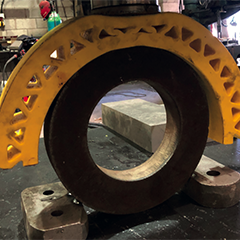Andrew Wickham, Managing Director at Buoyant works, has been involved in impact protection design, engineering and manufacture for the past 25 years. Developing and creating brands such as Hippo Marine and Manuplas, both long standing manufacturers of fendering, booms, buoys and other impact absorbing structures, has pioneered a new design. WindShield is a long-term protection system for the boat landing piles on offshore wind turbines, using established seaworthy materials that will work with the bow fender systems of the Crew Transfer Vessels (CTV).
Coating failures on the landing piles of offshore wind turbines are beginning to cost O&M firms increasing sums of money to maintain and repaint. These are critical structures used to facilitate the safe transfer of maintenance crews onto the turbines. The failure of a coating can result in corrosion of the steel structure, accelerating wear and reducing its lifespan. Crew transfers may become compromised, potentially unsafe and could lead to further damage of the turbine and the crew vessel.
The three participants in the crew transfer process are the crew, the turbine and the pilot vessel. All of them need to work together to create the safest possible environment. Operations need to be efficient and effective to avoid untimely delays and hit weather windows accurately. Creating an engineered relationship between the bow fender and the landing pile, to enable safer transition from vessel to ladder, is one possible solution.
Driving the bow of the CTV into the 2 vertical landing piles and holding it in place with skilled piloting, is the accepted practice and means that technicians can step from one to another. By applying engine power, the compressive bow fender structure on the vessel develops friction and grips to these piles. Once sufficient grip has been generated, the vessel will remain stationary while an engineer steps off the bow and onto the central ladder.






























